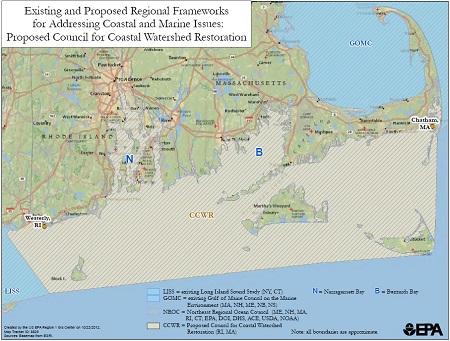The Southeast New England Program and the Buzzards Bay NEP
In 2014, the U.S. Environmental Protection Agency (U.S. EPA) received funding to implement a new initiative called the Southeast New England Program (originally called the Southeast New England Coastal Watershed Restoration Program) for the waters and watersheds of southeast New England in Rhode Island and Massachusetts. The goal of this initiative is to bring together public and private stakeholders to collaborate on initiatives to protect, enhance, and restore watersheds along southeast New England. The geographic area of the Program includes the coastal waters and watershed lands spanning from Westerly, Rhode Island to Pleasant Bay, Massachusetts. The watersheds of Narragansett Bay, Buzzards Bay, the south side of Cape Cod, and the Islands face similar opportunities and challenges. The Program's goal is to help promote and develop innovative and effective approaches to preserve and restore the region's critical resources. This website has been established to promote Southeast New England Program activities in the Buzzards Bay watershed. We maintain this legacy website to provide information about the origins of SNEP, the role of the Buzzards Bay NEP in support SNEP, and to provide documents and reports related to grants that we awarded and activities of our partners.
The partners of the Southeast New England Program currently include U.S. EPA's Region 1, U.S. EPA's Office of Research and Development, U.S. Army Corps of Engineers, National Oceanic and Atmospheric Administration, U.S. Fish and Wildlife Service, U.S. Department of Agriculture's Natural Resources Conservation Service (Rhode Island and Massachusetts districts), Narragansett Bay Estuary Program, Buzzards Bay National Estuary Program, Rhode Island Department of Environmental Management, Rhode Island Coastal Resources Management Council, Massachusetts Office of Coastal Zone Management, Massachusetts Department of Environmental Protection, Massachusetts Department of Fish and Game - Division of Ecological Restoration, Cape Cod Commission, Save the Bay, Buzzards Bay Coalition, The Nature Conservancy, and the Association to Preserve Cape Cod.
The Program's goals are to improve water quality, to restore physical processes, and to restore critical habitat. Traditionally, agencies and non-governmental organizations have addressed these problems separately, but the Southeast New England Program will take advantage of the opportunity to connect these ecological objectives by focusing on projects that increase the collaboration between different types of restoration activities. The Program will adopt a holistic, systems-based approach to restoration by incorporating a variety of integrated management approaches that address the region's broad set of stressors and disturbances. These strategies include increasing regional collaboration and communication, integrating new technologies into restoration projects, and applying the latest scientific developments.
Priorities for SNEP
The Southeast New England Program has a long-term agenda that includes the protection, enhancement, and restoration of clean water, healthy diverse habitats, and associated populations of fish, shellfish, and other aquatic dependent organisms. However, for the first year of funding in 2014, the program focused on the critical issue of nutrient pollution (both nitrogen and phosphorus loadings), and only funded projects designed to prevent or reduce sources of nutrient pollution. Go to our Grant Funding to see a description of the 2014 awards. In the 2015 grant round, the focus was expanded to include projects that address fresh or marine water quality degradation from nutrients, pathogens, and stormwater. In the Fall 2015 grant round, funding areas may expand further.
2014 SNEP Grants
On October 15, 2014, the Buzzards Bay NEP awarded $728,559 in 6 grants in support of the Southeast New England Program. Go to our Program Funding page to read about the awards.
2015 SNEP Grants
The U.S. EPA received $5 million for federal FY2015 in support of the SNEP initiative. Approximately $1.5 million of this was released through EPA New England's Healthy Communities Grant Program, with funding released according this 2015 application guidance, and submitted through Grants.Gov. The deadline for pre-proposals for Healthy Communities was April 30, 2015, and the grants were be announced in the fall of 2015 (see the HC website. In the summer of 2015, the Buzzards Bay and Narragansett Estuary Programs each issued a request for proposals in support of projects that address water quality degradation caused by nutrients (nitrogen and phosphorus) and pathogens and stormwater. The Buzzards Bay NEP administered these funds through the Massachusetts Executive Office of Energy and Environmental Affair. The Buzzards Bay NEP received 13 pre-proposals totaling $1,843,697, and awarded $794,478 to six entities in the Buzzards Bay watershed. Read EEA's press release to learn more.
2016 EPA WQ Grants
In December 2015, the U.S. EPA announced that up to $7 million dollars in SNEP funds over two years. Preproposals were due January 22 for 2016 funding. The Buzzards Bay NEP put together this fact sheet and request for assistance form in support of EPA's grant program. Awards under this program are contained on EPA's Southeast New England Program website.
2017 and 2018 RAE Grants
In 2017, the U.S. EPA announced that the non-profit Restore America's Estuaries (RAE) would be managing SNEP implementation grants as part of a five-year grant award. In January 2018, RAE announced the availability of the first round of SNEP grants they would award, and in January 2019, they announced their second round of SNEP grants. These solicitation have targeted water pollution, habitat degradation, and other high-priority environmental issues, in order to foster sustainable coastal and watershed communities in Rhode Island and Southeastern Massachusetts. More information about the RAE's SNEP grants can be found at Restore Americas Estuaries SNEP website.

